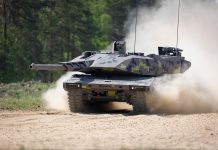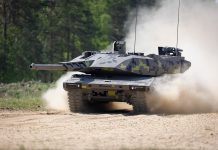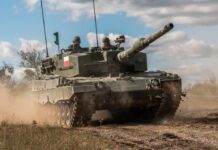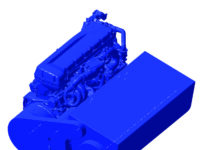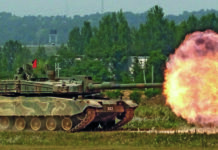As the West continues to reorient to conventional warfare in the face of a confrontational Russia, the need to continue to develop ammunition for Main Battle Tanks (MBT) in order to assure overmatch against the latest Russian tanks including T-72B3M and T-90M is critical.
While many countries continue to develop ammunition for existing 120mm guns, France and Germany are continuing to develop and mature technology for the future of MBT armament.
120mm
For the time being at least, 120mm remains the standard large direct fire calibre for tanks in the West, and indeed in much of the world other than those supplied by Russia and China. Commensurately, 120mm has seen some of the most active development, with new natures and weapons having been revealed recently. It is broadly agreed that 120mm is near its zenith of performance, and that any further step change capabilities beyond those currently planned will require an increase in calibre or an as-yet unknown materials science breakthrough.
France
In March 2021, Nexter unveiled their latest APFSDS round development, the 120 SHARD. This round is in the final stages of development ahead of a move to series production from early 2022 and is stated by the company to have been optimised to be capable of defeating all current and future passive and reactive armour systems.
The claim has not been validated with empirical data but would need to be performing at or beyond those of the latest peer penetrators including the US M829A4, which utilises a Depleted Uranium (DU) penetrator. SHARD is stated to use a combustible cartridge case with a D10 tungsten carbide alloy penetrator developed in concert with Plansee Tungsten Alloys. The key difference to existing French rounds such as F18 and F18+ is the penetrator length. Following extensive developmental work the length has been significantly increased, and the propellant volume also increased following a reengineering of the sabot, petal and case, leading to a claimed 20 per cent increase in penetrative performance when compared to existing rounds.
The 120 Shard is part of a family of new French 120mm rounds that includes the POLYNEGE guided round, which is able to terminally guide onto a designated target including Non-Line of Sight (NLOS) engagements at up to 8 km using technology developed from the Nexter KATANA 155mm artillery round. A programmable High Explosive (HE) round is also being developed to provide a broadly similar capability set as the US XM1147 Advanced Multi-Purpose (AMP) round.
Beyond ammunition, Nexter is also developing an all-new tank gun, the Autoloaded and SCALable Outperforming guN (ASCALON). ASCALON is a novel design approach, using cased telescoped approach to ammunition in a large calibre format with an “open architecture” approach that the company hopes will see it form the basis of a future Franco-German MBT under the Main Ground Combat System (MGCS) programme.
The cased telescoped approach allows, says the company, an unparalleled length of penetrator to be achieved with an overall projectile length of 1,300 mm delivering equivalent or superior performance to existing 120mm APFSDS rounds but with reduced muzzle blast and more readily integrated with lighter weight platforms than typical MBT applications.
Germany
As could be expected given its strong track record in the manufacture and development of smoothbore 120mm guns, which arm a substantial portion of the world’s MBTs either directly or via licenced production and development, Germany is very active in development of new versions of its gun and of new ammunition natures for them.
In response to a need to continue to improve the performance of the 120mm smoothbore gun design, Rheinmetall developed the improved L55A1 standard in 2016. The main difference between the baseline L55 and the L55A1 is an increased pressure level resulting in a claimed 20 per cent increase in penetration.
The L55A1 is the de-facto standard weapon for latest examples of the LEOPARD 2 MBT, with the latest LEOPARD 2A7-series, including the LEOPARD 2A7V, LEOPARD 2A7A1 and LEOPARD 2A7DK utilising the gun, as well as the guns for the Hungarian LEOPARD 2A7 purchase.
The legacy DM53 APFSDS projectile has already been improved to the DM63 standard, which replaces propellant with an Insensitive Munitions (IM) compliant component. The latest DM73 has taken the DM53/63 projectile and through the use of a more powerful propellant achieves an 8 per cent uplift in performance, and entered qualification trials with the Bundeswehr Technical Centre for Weapons and Ammunition earlier this year. DM53 rounds can be upgraded to DM63 or DM73 standard to reduce costs versus wholesale replacement of rounds.
Looking further ahead, Germany is developing the KE2020Neo, an all-new APFSDS design intended to take the capability of 120mm armed tanks significantly up in capability by leveraging the full additional pressure margins of the L55A1 gun. The novel penetrator design is also seeking to improve on velocity and terminal energy losses experienced due to drag, likely by increase length to diameter ratio of the round. Once more developed the round will be assigned a DM designation with a target fielding date of 2025, and early claims cite a potential 20 per cent improvement in performance.
The KE2020Neo is also being looked at by the UK as a potential service KE round for the new CHALLENGER 3 MBT, being assessed against the US M829A4 depleted uranium round. A decision on which round the UK will use will be taken at CHALLENGER 3 Critical Design Review (CDR) in 2022.
The US
The US has been somewhat more measured in its development of new large calibre weapons and munitions than its European neighbours, with only modest programmes around non-KE projectiles. The M256 gun, derived from the German 120mm smoothbore L44 gun family, remains the primary armament of the M1 ABRAMS tank fleet and is not expected to be replaced or upgraded in the near term.
The latest generation M829A4 APFSDS round, introduced in 2015, remains the service round for KE engagement, and remains a rare example of depleted uranium based penetrator design, where most users utilise tungsten-based designs. For US needs, the M829A4 appears to remain suitable, and instead effort has been directed to the consolidation of legacy ammunition types to a single nature under the XM1147 Advanced Multi-Purpose (AMP) effort. XM1147 AMP consolidates the capabilities of the M830 HIgh Explosive Anti-Tank Multi-Purpose With Tracer (HEAT‑MP-T), the M830A1 HEAT-MP-T, the M1028 CANISTER (CAN) round, and the M908 Obstacle Reducing With Tracer (OR-T) rounds into a single multipurpose ammunition nature. This would allow US tanks to deploy with just a two-round load, vastly increasing ease of supply and operation.
130mm
Rheinmetall continues to work on its L/51 130mm tank gun, first unveiled at the 2016 Eurosatory defence exhibition. The 8 per cent increase in calibre of the weapon over the 120mm gun from which its design is derived brings a claimed 50% increase in penetrative capability. The increase in size carries with it an increase in weight of around 500 kg. With a 50 per cent increase in chamber volume, the gun allows longer APFSDS round to be fired at higher velocities, with a target of reaching a 13-14 MJ impact energy target.
The single piece ammunition for a 130mm smoothbore gun is substantially larger than existing 120mm natures and would necessitate the use of an autoloader when fitted to a vehicle. The size and weight of the projectiles is too great to be handled by a single member of crew in the tight confines of a tank turret. It should also be noted that a move to a larger 130mm gun would significantly reduce the number of rounds that can be carried and require an all-new turret to be designed for most tanks, as the 130mm does not readily fit in existing turrets without major structural modification.
The first round developed for the 130mm system is an APFSDS round, with a high-explosive air bursting munition (HE ABM) derived from the 120mm DM11 programmable HE round. One of the desires of the 130mm APFSDS is that it could engage targets at 4.5 km or more. However, there is some doubt as to whether a round could be sufficiently accurate and carry enough terminal energy to be effective at that range. There has been suggestion that a guided round or missile would be better suited to such long-range engagement envelopes.
Rheinmetall hopes that the MGCS design being jointly developed by France and Germany, will mount the 130mm gun, however it competes against a French desire to mount a larger still 140mm gun made by Nexter.
In early 2021, Rheinmetall characterised the 130mm gun as being around technology readiness level two or three, with the gun itself at around level three and the autoloader system around level two. With no committed customers at this time, Rheinmetall appear to be waiting for a decision on which weapon will form the main armament of the MGCS, due to be decided in 2022, before committing to faster development of the weapon system.
140mm
Nexter have long had a desire to market a 140mm tank gun, heavier than any other Western effort at present which is in many ways surprising given France’s preference for lighter and predominantly wheeled forces. The company’s 140mm tank gun is a vast increase in size and weight over a conventional 120mm gun and is claimed to bring with it a substantial increase in performance.
In 2019, footage was released by Nexter of the 140mm gun mounted to a LECLERC tank during static firing trials, not representing a potential application of the weapon for LECLERC but as a testbed platform to develop the weapon towards a notional application as the main armament of a relatively light tank, specifically the 50 tonne target for the MGCS tank. As previously stated, the German side of the MGCS team would like to see the Rheinmetall 130mm gun used for MGCS, so a future down-select on main armament will need to take place, or less likely would be a divergence to two differing turrets and armaments to accommodate both countries. Nexter’s 140mm gun draws lineage back to around 1990 when GIAT started development of the weapon and an enlarged turret called the T4 to mount it.
The 140mm gun is larger and more powerful than extant 120mm weapons, with Nexter claiming up to 70 per cent increase in performance compared to contemporary 120mm ammunition natures.
Prior investigations by Germany, Switzerland, the UK and the US all in broad terms discounted it as though it brings substantial capability uplifts, the engineering burdens of handling the huge recoil impulses, and the practicality of handling and autoloading the vastly larger 140mm rounds, with commensurate decrease in total round capacity in the platform rendered it not good value versus smaller calibres. France has much of this data and knowledge but appears to remain resolute that a 140mm gun is still their preferred capability.




![MGCS status update The KNDS EMBT-ADT 140 technology demonstrator on display at the Eurosatory 2024 exhibition. This model featured the 140 mm configuration of the ASCALON gun. [Mark Cazalet]](https://euro-sd.com/wp-content/uploads/2025/08/EMBT-EDT-140_Mark-Cazalet-Kopie-218x150.jpg)


